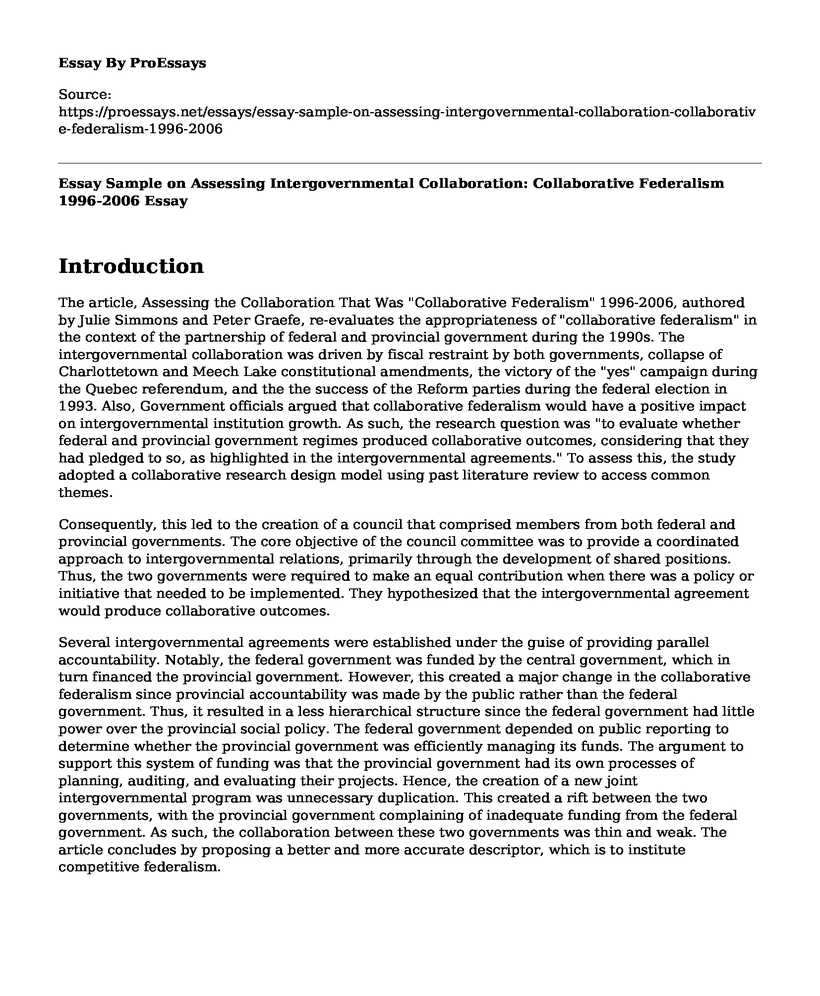Introduction
The article, Assessing the Collaboration That Was "Collaborative Federalism" 1996-2006, authored by Julie Simmons and Peter Graefe, re-evaluates the appropriateness of "collaborative federalism" in the context of the partnership of federal and provincial government during the 1990s. The intergovernmental collaboration was driven by fiscal restraint by both governments, collapse of Charlottetown and Meech Lake constitutional amendments, the victory of the "yes" campaign during the Quebec referendum, and the the success of the Reform parties during the federal election in 1993. Also, Government officials argued that collaborative federalism would have a positive impact on intergovernmental institution growth. As such, the research question was "to evaluate whether federal and provincial government regimes produced collaborative outcomes, considering that they had pledged to so, as highlighted in the intergovernmental agreements." To assess this, the study adopted a collaborative research design model using past literature review to access common themes.
Consequently, this led to the creation of a council that comprised members from both federal and provincial governments. The core objective of the council committee was to provide a coordinated approach to intergovernmental relations, primarily through the development of shared positions. Thus, the two governments were required to make an equal contribution when there was a policy or initiative that needed to be implemented. They hypothesized that the intergovernmental agreement would produce collaborative outcomes.
Several intergovernmental agreements were established under the guise of providing parallel accountability. Notably, the federal government was funded by the central government, which in turn financed the provincial government. However, this created a major change in the collaborative federalism since provincial accountability was made by the public rather than the federal government. Thus, it resulted in a less hierarchical structure since the federal government had little power over the provincial social policy. The federal government depended on public reporting to determine whether the provincial government was efficiently managing its funds. The argument to support this system of funding was that the provincial government had its own processes of planning, auditing, and evaluating their projects. Hence, the creation of a new joint intergovernmental program was unnecessary duplication. This created a rift between the two governments, with the provincial government complaining of inadequate funding from the federal government. As such, the collaboration between these two governments was thin and weak. The article concludes by proposing a better and more accurate descriptor, which is to institute competitive federalism.
References
Simmons, J. M., & Graefe, P. (2013). Assessing the collaboration that was "collaborative federalism" 1996-2006. Canadian Political Science Review, 7(1), 25-36.
Cite this page
Essay Sample on Assessing Intergovernmental Collaboration: Collaborative Federalism 1996-2006. (2023, Apr 28). Retrieved from https://proessays.net/essays/essay-sample-on-assessing-intergovernmental-collaboration-collaborative-federalism-1996-2006
If you are the original author of this essay and no longer wish to have it published on the ProEssays website, please click below to request its removal:
- The True Damage to Trump's 'Fake News' - Article Analysis Assignment
- Mental Health Access Issue in Massachusetts Paper Example
- Essay Sample on Potential Positive or Negative Externality
- Rich World Economies: Public Institutions, Policies & Jobs - Essay Sample
- Expanding First Amendment Reach in the Age of Social Media - Essay Sample
- Effectiveness of NRF & NIMS in Disaster Response - Essay Sample
- Free Essay Example on The Godfather Doctrine: Examining US Foreign Policy







